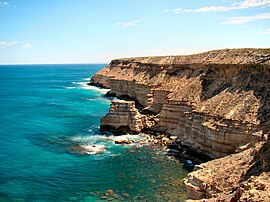Kalbarri National Park
|
Kalbarri National Park Western Australia |
|
|---|---|
|
IUCN category II (national park)
|
|

From the coastal section of the park, cliffs running south from the town of Kalbarri.
|
|
| Nearest town or city | Kalbarri |
| Coordinates | 27°47′05″S 114°14′45″E / 27.78472°S 114.24583°ECoordinates: 27°47′05″S 114°14′45″E / 27.78472°S 114.24583°E |
| Established | 1963 |
| Area | 1,830.05 km2 (706.6 sq mi) |
| Managing authorities | Department of Parks and Wildlife (DPaW) |
| Website | Kalbarri National Park |
| See also | List of protected areas of Western Australia |
Kalbarri National Park is located 485 km (301 mi) north of Perth, in the Mid West region of Western Australia.
The major geographical features of the park include the Murchison River gorge which runs for nearly 80 km (50 mi) on the lower reaches of the Murchison River. Spectacular coastal cliffs are located on the coast near the mouth of the Murchison River and the town of Kalbarri.
Kalbarri National Park preserves the inland desert regions of red and white striped Tumblagooda sandstone east of the town of Kalbarri, particularly the lower reaches of the Murchison River and its gorge, as well as the mouth of the river by Meanarra Hill.
The western edge of the park protects the coastline south of the town which features cliffs more than 100 m (328 ft) high. The coastal area contains several wind and water eroded rock formations including a sea stack and a natural bridge.
The park is open all year round though temperatures can be extremely high from December through April. The park lies in the northernmost limits of the transition zone between a Mediterranean and a semi-arid climate. Winters are warm with moderate precipitation. Summers are hot and dry with temperatures that frequently exceed 40 °C (104 °F) in the inland part of the park. Inland areas can often be more than 10 °C (18 °F) higher than along the coast and in town. Monthly precipitation levels are low with most rain falling from May through August. Heavy rainfalls may cause the roads to the gorge to be closed.
The Kalbarri area is known for its diversity and extent of wildflowers. More than 800 species of wildflowers bloom from late winter through early summer with peak times in August and September. Twenty-one plant species are found only in the coastal cliff tops and gorge country predominantly in the National Park. One of the best known local plants is the Kalbarri catspaw, a small yellow or red plant that is usually seen on recently burnt country from August to September. Several orchids can only be seen in and near the park, including the Kalbarri spider orchid and the Murchison hammer orchid.
...
Wikipedia

